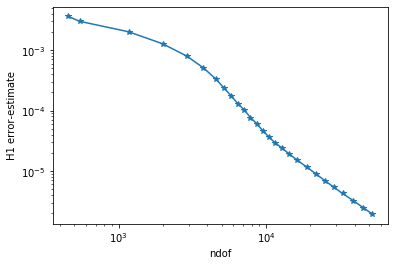This page was generated from unit-1.6-adaptivity/adaptivity.ipynb.
1.6 Error estimation & adaptive refinement¶
In this tutorial, we apply a Zienkiewicz-Zhu type error estimator and run an adaptive loop with these steps:
[1]:
from ngsolve import *
from ngsolve.webgui import Draw
from netgen.geom2d import SplineGeometry
import matplotlib.pyplot as plt
Geometry¶
The following geometry represents a heated chip embedded in another material that conducts away the heat.
[2]:
# point numbers 0, 1, ... 11
# sub-domain numbers (1), (2), (3)
#
#
# 7-------------6
# | |
# | (2) |
# | |
# 3------4-------------5------2
# | |
# | 11 |
# | / \ |
# | 10 (3) 9 |
# | \ / (1) |
# | 8 |
# | |
# 0---------------------------1
#
def MakeGeometry():
geometry = SplineGeometry()
# point coordinates ...
pnts = [ (0,0), (1,0), (1,0.6), (0,0.6), \
(0.2,0.6), (0.8,0.6), (0.8,0.8), (0.2,0.8), \
(0.5,0.15), (0.65,0.3), (0.5,0.45), (0.35,0.3) ]
pnums = [geometry.AppendPoint(*p) for p in pnts]
# start-point, end-point, boundary-condition, left-domain, right-domain:
lines = [ (0,1,1,1,0), (1,2,2,1,0), (2,5,2,1,0), (5,4,2,1,2), (4,3,2,1,0), (3,0,2,1,0), \
(5,6,2,2,0), (6,7,2,2,0), (7,4,2,2,0), \
(8,9,2,3,1), (9,10,2,3,1), (10,11,2,3,1), (11,8,2,3,1) ]
for p1,p2,bc,left,right in lines:
geometry.Append(["line", pnums[p1], pnums[p2]], bc=bc, leftdomain=left, rightdomain=right)
geometry.SetMaterial(1,"base")
geometry.SetMaterial(2,"chip")
geometry.SetMaterial(3,"top")
return geometry
mesh = Mesh(MakeGeometry().GenerateMesh(maxh=0.2))
Spaces & forms¶
The problem is to find \(u\) in \(H_{0,D}^1\) satisfying
for all \(v\) in \(H_{0,D}^1\). We expect the solution to have singularities due to the nonconvex re-enrant angles and discontinuities in \(\lambda\).
[3]:
fes = H1(mesh, order=3, dirichlet=[1])
u, v = fes.TnT()
# one heat conductivity coefficient per sub-domain
lam = CoefficientFunction([1, 1000, 10])
a = BilinearForm(fes)
a += lam*grad(u)*grad(v)*dx
# heat-source in inner subdomain
f = LinearForm(fes)
f += CoefficientFunction([0, 0, 1])*v * dx
c = Preconditioner(a, type="multigrid", inverse="sparsecholesky")
gfu = GridFunction(fes)
Draw (gfu)
[3]:
BaseWebGuiScene
Note that the linear system is not yet assembled above.
Solve¶
Since we must solve multiple times, we define a function to solve the boundary value problem, where assembly, update, and solve occurs.
[4]:
def SolveBVP():
fes.Update()
gfu.Update()
a.Assemble()
f.Assemble()
inv = CGSolver(a.mat, c.mat)
gfu.vec.data = inv * f.vec
[5]:
SolveBVP()
Draw(gfu)
[5]:
BaseWebGuiScene
Estimate¶
We implement a gradient-recovery-type error estimator. For this, we need an H(div) space for flux recovery. We must compute the flux of the computed solution and interpolate it into this H(div) space.
[6]:
space_flux = HDiv(mesh, order=2)
gf_flux = GridFunction(space_flux, "flux")
flux = lam * grad(gfu)
gf_flux.Set(flux)
Element-wise error estimator: On each element \(T\), set
where \(u_h\) is the computed solution gfu and \(I_h\) is the interpolation performed by Set in NGSolve.
[7]:
err = 1/lam*(flux-gf_flux)*(flux-gf_flux)
Draw(err, mesh, 'error_representation')
[7]:
BaseWebGuiScene
[8]:
eta2 = Integrate(err, mesh, VOL, element_wise=True)
print(eta2)
4.77712e-10
3.62503e-08
4.73264e-06
1.39888e-10
2.56218e-10
1.68139e-08
3.89785e-08
1.7684e-07
1.2484e-07
2.62242e-07
1.30604e-07
6.66851e-09
4.49294e-07
3.21719e-06
6.65763e-07
2.49744e-08
2.56941e-07
4.0863e-06
1.39265e-07
5.1322e-07
9.93688e-08
1.22606e-06
4.89833e-10
1.05638e-06
5.005e-07
1.03982e-06
9.39238e-10
1.62172e-06
3.01972e-08
5.35648e-07
4.09083e-09
2.08152e-07
1.12974e-10
1.18657e-11
1.58514e-10
1.45496e-11
1.91237e-11
2.16696e-12
8.72612e-07
8.31556e-07
The above values, one per element, lead us to identify elements which might have large error.
Mark¶
We mark elements with large error estimator for refinement.
[9]:
maxerr = max(eta2)
print ("maxerr = ", maxerr)
for el in mesh.Elements():
mesh.SetRefinementFlag(el, eta2[el.nr] > 0.25*maxerr)
maxerr = 4.732636652056738e-06
Refine & solve again¶
Refine marked elements:
[10]:
mesh.Refine()
SolveBVP()
Draw(gfu)
[10]:
BaseWebGuiScene
Automate the above steps¶
[11]:
l = [] # l = list of estimated total error
def CalcError():
# compute the flux:
space_flux.Update()
gf_flux.Update()
flux = lam * grad(gfu)
gf_flux.Set(flux)
# compute estimator:
err = 1/lam*(flux-gf_flux)*(flux-gf_flux)
eta2 = Integrate(err, mesh, VOL, element_wise=True)
maxerr = max(eta2)
l.append ((fes.ndof, sqrt(sum(eta2))))
print("ndof =", fes.ndof, " maxerr =", maxerr)
# mark for refinement:
for el in mesh.Elements():
mesh.SetRefinementFlag(el, eta2[el.nr] > 0.25*maxerr)
[12]:
CalcError()
mesh.Refine()
ndof = 454 maxerr = 2.7688802617430683e-06
Run the adaptive loop¶
[13]:
while fes.ndof < 50000:
SolveBVP()
Draw(gfu)
CalcError()
mesh.Refine()
ndof = 547 maxerr = 9.146694947653071e-07
ndof = 1168 maxerr = 3.3095643866613105e-07
ndof = 1984 maxerr = 1.1989057172284683e-07
ndof = 2890 maxerr = 4.345861427990931e-08
ndof = 3760 maxerr = 1.8502837118369898e-08
ndof = 4567 maxerr = 9.244837693813689e-09
ndof = 5176 maxerr = 4.6204803186765176e-09
ndof = 5821 maxerr = 2.309162045158309e-09
ndof = 6493 maxerr = 1.1540216232649537e-09
ndof = 7120 maxerr = 5.76730848064252e-10
ndof = 7828 maxerr = 2.882220070577976e-10
ndof = 8623 maxerr = 1.4405127779774572e-10
ndof = 9478 maxerr = 7.199428264000819e-11
ndof = 10426 maxerr = 3.598115477010617e-11
ndof = 11533 maxerr = 1.7982704681069e-11
ndof = 12796 maxerr = 8.987379799946089e-12
ndof = 14356 maxerr = 4.4917190472922574e-12
ndof = 16321 maxerr = 2.2448904116724975e-12
ndof = 18976 maxerr = 1.1219581043521356e-12
ndof = 21676 maxerr = 5.607213445601362e-13
ndof = 25231 maxerr = 2.802356519158675e-13
ndof = 28792 maxerr = 1.4005404205328162e-13
ndof = 33070 maxerr = 6.999472593974982e-14
ndof = 39082 maxerr = 3.498138090876314e-14
ndof = 45721 maxerr = 1.748216129728819e-14
ndof = 52705 maxerr = 8.736920721376666e-15
Plot history of adaptive convergence¶
[14]:
plt.yscale('log')
plt.xscale('log')
plt.xlabel("ndof")
plt.ylabel("H1 error-estimate")
ndof,err = zip(*l)
plt.plot(ndof,err, "-*")
plt.ion()
plt.show()

[ ]: